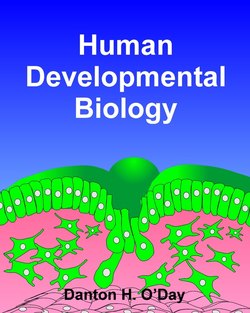Читать книгу Human Developmental Biology - Danton Inc. O'Day - Страница 13
BMP and DAZ Genes and Human Germ Cell Formation
ОглавлениеVarious genes and factors are important in PGC migration and differentiation (Figure 2.7). Bone morphogenetic protein (BMP; originally revealed as a factor involved in bone morphogenesis) has been proven to be critical since mice with null mutations in the gene encoding Bmp4 lack primordial germ cells. While germ-line determination is likely to differ from other animals in many specific ways, work on lower forms has guided the direction of human studies. For example, over the last few years, another gene first identified in Drosophila as being important in germ cell development has also been shown to function in germ cell formation in humans. Mutations in the human DAZ gene (Deleted in Azoospermia) and/or its homologs can result in the absence of either eggs or sperm cells. The exact role of DAZ in human spermatogenesis is under analysis. Oct4, a nuclear transcription factor, also appears to be critical for the origin of PGCs since it is expressed in cell lineages that give rise to PGCs as well as in PGCs and oocytes but not in sperm once they are in the testes.
Figure 2.4. Genes and other factors involved in PGC migration and differentiation.
Clearly, we could spend many chapters on this topic for there is much more to be known about molecular determinants and their functions in germ plasm formation and gametogenesis. The point to be made here is that current molecular methods, coupled with traditional approaches are beginning to shed light on a problem that is fundamental to life and that has concerned scientists for over 100 years.
Our understanding of human development has come from the extensive knowledge gained from pure research on lower animals. Such past and present research continues to guide ongoing research in human embryology and development. Early during development, the fate of the primordial germ cells is determined by endogenous factors (determinants) in lower animals. As expected, the determinants have been found to be genetically controlled. Specific mRNAs appear to be the cytoplasmic determinants that underlie the formation of germ cells. Some likely candidates have been identified and soon the whole molecular and cellular story of germ cell determination will be revealed. Humans share similarities in some of the genes that control germ cell formation. After the PGCs have migrated into the genital ridges, external factors (including hormones) will now influence their further development. Cells that get lost, don't get influenced by a normal set of factors and, as a result, in some instances can form cancerous teratomas. In the female, the number of germ cells increases by mitosis which then stops so that only a limited number of eggs are possible. In fact, as we will see in the next chapter, millions of potential eggs will die. In the male, mitosis and meiosis continue throughout life so a continual supply of sperm is available. The stage is now set for the formation of eggs and sperm. The next chapter examines oogenesis.
